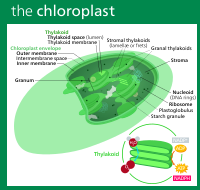
Photo from wikipedia
Ammonium recovery from wastewater by gas-permeable membranes is promising but suffers from the tradeoff between membrane stability and permeability under harsh operating conditions. Chemical-resistant membranes display modest permeability due to… Click to show full abstract
Ammonium recovery from wastewater by gas-permeable membranes is promising but suffers from the tradeoff between membrane stability and permeability under harsh operating conditions. Chemical-resistant membranes display modest permeability due to the poor solubility and processibility; chemically active membranes are easier to be endowed with better permeability however hinder by instability. To resolve such a problem, we cleverly design a novel membrane configuration via one-step solution-electrospinning, with the chemical-active component (low-strength fluorine polymer) as the inner skeleton to construct interconnected porous structures and the chemical-resistant component (high-strength fluorine polymer) as the outer armor to serve as a protective layer. Due to the significantly enhanced mass transfer coefficient, the interconnected-porous armor-structured membrane exhibited much higher permeability for NH4+-N recovery, which was 1.4 and 5 times that of the traditional PTFE membrane and PP membrane, respectively. Through long-term intermittent and consecutive experiments, the reusability and durability of the armor-structured nanofibrous membrane were verified. When treating actual hoggery wastewater with complicated water quality, the armor-structured nanofibrous membrane also displayed robust stable performance with excellent antiwettability. The mechanisms of membrane formation, corrosion resistance, and mass transfer were discussed in detail.
Journal Title: Environmental science & technology
Year Published: 2022
Link to full text (if available)
Share on Social Media: Sign Up to like & get
recommendations!